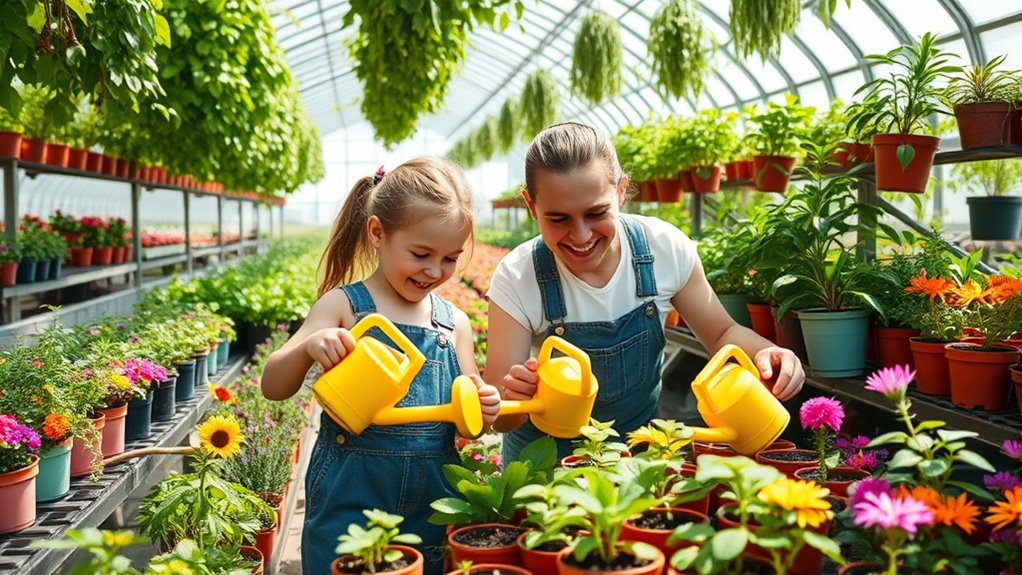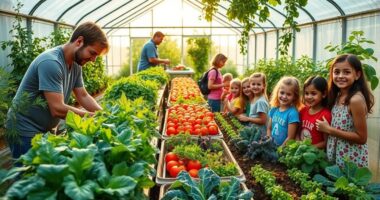Engaging your family in greenhouse gardening offers a fun way to spend quality time while teaching responsibility and sustainability. You can involve kids in watering, pruning, and monitoring soil moisture, making plant care a hands-on adventure. Incorporate composting to teach eco-friendly habits and use tools like HEPA filters to keep the environment healthy. These activities inspire curiosity and foster a love for nature—keep exploring to discover more ways to create memorable gardening experiences with your family.
Key Takeaways
- Engage kids in watering, pruning, and adjusting plant placement to teach responsibility and hands-on gardening skills.
- Use the greenhouse to demonstrate composting, fostering sustainability awareness and environmental responsibility.
- Turn plant care routines into fun activities by setting goals and tracking growth progress together.
- Involve children in selecting plants and learning about sunlight, soil, and growth cycles for an educational experience.
- Create themed gardening projects or challenges to make family gardening time interactive and memorable.

Gardening is a wonderful way to spend quality time together as a family while teaching kids about nature and responsibility. When you bring your efforts indoors with a greenhouse, you create a controlled environment that makes learning about plant care more engaging and manageable. Kids love seeing their efforts turn into thriving plants, and a greenhouse offers an ideal space for hands-on activities that develop their understanding of growth cycles, soil health, and responsibility. To make the most of this experience, focus on teaching proper plant care. Show your children how to water plants correctly, ensuring they understand that both overwatering and underwatering can harm the plants. Explain the importance of sunlight, and demonstrate how to adjust plant placement to maximize exposure. As they become more confident, involve them in checking soil moisture levels and pruning when necessary. These small tasks help instill a sense of responsibility and patience.
Engage kids in watering, sunlight, and pruning to teach responsibility and foster a love for gardening.
In addition to plant care, introducing composting tips can deepen their understanding of sustainability. Use the greenhouse as an example to show how composting turns organic waste into nutrient-rich soil, which benefits your plants and reduces household waste. Teach your kids what materials are compostable, like fruit peels, coffee grounds, and shredded paper, and explain why avoiding certain items, like meat or dairy, is essential. Setting up a compost bin inside or near the greenhouse allows children to see the decomposition process firsthand. Regularly involving them in turning the compost and monitoring its progress makes the concept tangible. This activity not only teaches environmental responsibility but also provides natural fertilizer for your plants, which can improve plant health and growth.
Additionally, understanding the importance of HEPA filtration can help you choose the right tools for maintaining a healthy environment around your greenhouse and home. Involving your children in composting tips and plant care routines helps them understand the importance of nurturing living things and respecting the environment. It’s a practical way to teach them about sustainability and resourcefulness. As they observe the positive effects of compost on their plants, they’ll feel a sense of accomplishment and ownership. Keep the process fun by encouraging questions and letting them make decisions within safe boundaries. For example, you might ask, “What should we add to our compost today?” or “How do you think this plant is feeling?” These interactions make gardening more than just a chore—it becomes a shared adventure that cultivates curiosity, responsibility, and joy for the whole family.
Through consistent involvement in plant care and composting tips, your children develop valuable skills and a lasting appreciation for nature. The greenhouse becomes a place of discovery where you nurture not just plants but also a love for the environment and each other.
Frequently Asked Questions
What Safety Precautions Should Parents Take During Greenhouse Activities?
When engaging in greenhouse activities, you should prioritize safety by practicing hazard prevention and using protective gear. Always supervise children closely, ensuring they wear gloves, goggles, and proper footwear to prevent injuries. Keep pathways clear to avoid tripping, and handle tools carefully. Regularly check for hazards like sharp objects or chemicals, and teach kids safety rules. Your proactive approach helps create a safe, fun environment for everyone involved.
How Can I Adapt Greenhouse Gardening for Very Young Children?
Think of your greenhouse as a magical garden where tiny hands can plant seeds with joy. To adapt for very young children, you’ll want to use child-friendly tools that are safe and easy to handle. Simplify planting tasks, like sprinkling soil or placing seedlings, making it fun and manageable. Always supervise closely, creating a safe space for little explorers to discover nature’s wonders and nurture their love for gardening.
What Are Some Eco-Friendly Gardening Tips for Families?
To practice eco-friendly gardening, start with composting tips like using kitchen scraps and yard waste to enrich your soil naturally. Choose native plant selection to support local ecosystems and reduce water needs. Encourage your family to participate in composting and plant native species, making gardening sustainable and educational. These simple steps help protect the environment while creating a beautiful, healthy garden you can enjoy together.
How Do I Maintain Greenhouse Temperature and Humidity for Kids’ Activities?
You manage climate control by regularly adjusting your greenhouse’s ventilation, heating, and shading. Use a hygrometer to monitor humidity and guarantee proper humidity regulation, preventing excess moisture or dryness. Keep temperature steady with thermostats and fans, creating a cozy environment that mirrors nature’s balance. By maintaining this harmony, you provide a safe, inviting space for kids to explore, learn, and enjoy greenhouse activities comfortably and confidently.
Are There Indoor Greenhouse Options Suitable for Small Spaces?
Yes, you can find indoor greenhouse options perfect for small spaces. Look for compact design models that fit easily into apartments or tiny rooms. These space-saving solutions often come with removable shelves and vertical growing systems, maximizing every inch. You’ll enjoy gardening indoors without sacrificing space, making it easy to nurture plants and create a green haven, even in limited areas.
Conclusion
Gardening together is like planting seeds of joy that blossom into cherished memories. As you nurture tiny sprouts and watch them thrive, you create a tapestry of shared laughter and learning. These moments bloom into a garden of family bonds, growing stronger with every activity. So, roll up your sleeves and let your little explorers immerse themselves in this green adventure—because the greatest harvest is the love you cultivate together.








